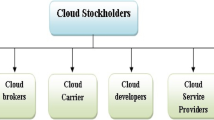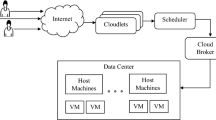Abstract
In recent years, cloud computing has emerged as the most popular technologies for accessing and delivering enterprise applications as the services to the end users over the Internet. Since different enterprises may offer web services with various capabilities, these web services can be combined with other to provide the complete functionality of a large software application to meet the users’ requests. Therefore, the service composition as an NP-hard optimization problem to combine the distributed and heterogeneous web services is introduced as a challenging issue. In this work, we propose a linear programming approach to web service composition problem which is called ‘LP-WSC’ to select the most efficient service per request in a geographically distributed cloud environment for improving the quality-of-service criteria. Finally, we evaluate the effectiveness of our approach under three scenarios with varying the number of atomic services per set. The experimental results indicate that the proposed approach significantly reduces the cost of selection and composition of the services and also increases the availability of services and the reliability of the servers compared with the other approaches.















Similar content being viewed by others
References
Souri A, Navimipour NJ, Rahmani AM (2017) Formal verification approaches and standards in the cloud computing: a comprehensive and systematic review. Comput Stand Interfaces 58:1–22
Souri A, Asghari P, Rezaei R (2017) Software as a service-based CRM providers in the cloud computing: challenges and technical issues. J Serv Sci Res 9(2):219–237
Ghobaei-Arani M et al (2018) An autonomic resource provisioning approach for service-based cloud applications: a hybrid approach. Fut Gen Comput Syst 78(1):191–210
Souri A, Norouzi M (2015) A new probable decision making approach for verification of probabilistic real-time systems. In: 6th IEEE International Conference on Software Engineering and Service Science (ICSESS), 2015. IEEE
Souri A, Shariflooa MA, Norouzia M (2012) Analyzing SMV & UPPAAL model checkers in real-time systems. Comput Sci 1:631–639
Buyya R, Broberg J, Goscinski AM (2010) Cloud computing: principles and paradigms, vol 87. Wiley, Hoboken
Rahmanian AA, Ghobaei-Arani M, Tofighy S (2018) A learning automata-based ensemble resource usage prediction algorithm for cloud computing environment. Fut Gen Comput Syst 79:54–71
Ghobaei-Arani M, Jabbehdari S, Pourmina MA (2016) An autonomic approach for resource provisioning of cloud services. Clust Comput 19(3):1017–1036
Safarkhanlou A et al (2015) Formalizing and verification of an antivirus protection service using model checking. Proc Comput Sci 57:1324–1331
Simon B, Goldschmidt B, Kondorosi K (2013) A metamodel for the web services standards. J Grid Comput 11(4):735–752
Piprani B, Sheppard D, Barbir A (2013) Comparative analysis of SOA and cloud computing architectures using fact based modeling. In: OTM Confederated International Conferences “On the Move to Meaningful Internet Systems”. Springer, Berlin
Portchelvi V, Venkatesan VP, Shanmugasundaram G (2012) Achieving web services composition—a survey. Softw Eng 2(5):195–202
Aslanpour MS, Ghobaei-Arani M, Toosi AN (2017) Auto-scaling web applications in clouds: a cost-aware approach. J Netw Comput Appl 95:26–41
Souri A, Rahmani AM, Jafari Navimipour N (2018) Formal verification approaches in the web service composition: a comprehensive analysis of the current challenges for future research. Int J Commun Syst 58:1–22. https://doi.org/10.1016/j.csi.2017.11.007
Hamzei M, Navimipour NJ (2018) Towards efficient service composition techniques in the internet of things. IEEE Internet Things J. https://doi.org/10.1109/JIOT.2018.2861742
Asghari S, Navimipour NJ (2018) Nature inspired meta-heuristic algorithms for solving the service composition problem in the cloud environments. Int J Commun Syst 31(12). https://doi.org/10.1002/dac.3708
Naseri A, Navimipour NJ (2018) A new agent-based method for QoS-aware cloud service composition using particle swarm optimization algorithm. J Ambient Intell Hum Comput. https://doi.org/10.1007/s12652-018-0773-8
Hajizadeh R, Jafari Navimipour N (2017) A method for trust evaluation in the cloud environments using a behavior graph and services grouping. Kybernetes 46(7):1245–1261
Jula A, Sundararajan E, Othman Z (2014) Cloud computing service composition: a systematic literature review. Expert Syst Appl 41(8):3809–3824
Vakili A, Navimipour NJ (2017) Comprehensive and systematic review of the service composition mechanisms in the cloud environments. J Netw Comput Appl 81:24–36
Ghobaei-Arani M et al (2017) CSA-WSC: cuckoo search algorithm for web service composition in cloud environments. Soft Comput. https://doi.org/10.1007/s00500-017-2783-4
Keshanchi B, Souri A, Navimipour NJ (2017) An improved genetic algorithm for task scheduling in the cloud environments using the priority queues: formal verification, simulation, and statistical testing. J Syst Softw 124:1–21
Suthaharan S (2016) Machine learning models and algorithms for big data classification. Springer, Berlin
Yu Q, Chen L, Li B (2015) Ant colony optimization applied to web service compositions in cloud computing. Comput Electr Eng 41:18–27
Gutierrez-Garcia JO, Sim K-M (2010) Agent-based service composition in cloud computing, In: Grid and distributed computing, control and automation. Springer, Berlin, pp 1–10
Bastia A et al (2015) Service composition using efficient multi-agents in cloud computing environment. In: Intelligent computing, communication and devices. Springer, Berlin, pp 357–370
Ye Z, Zhou X, Bouguettaya A (2011) Genetic algorithm based QoS-aware service compositions in cloud computing. In International Conference on Database Systems for Advanced Applications. Springer, Berlin
Bharathan S, Rajendran C, Sundarraj R (2017) Penalty Based Mathematical Models for Web Service Composition in a Geo-Distributed Cloud Environment. In IEEE International Conference on Web Services (ICWS), 2017. IEEE
Gao A et al (2005) Web service composition using integer programming-based models. In: IEEE International Conference on e-Business Engineering, ICEBE, 2005. IEEE
Akbaripour H et al (2018) Cloud manufacturing service selection optimization and scheduling with transportation considerations: mixed-integer programming models. Int J Adv Manuf Technol 95(1–4):43–70
Bhushan SB, Reddy PC (2018) A hybrid meta-heuristic approach for QoS-aware cloud service composition. Int J Web Serv Res (IJWSR) 15(2):1–20
Wang S et al (2013) Particle swarm optimization with skyline operator for fast cloud-based web service composition. Mob Netw Appl 18(1):116–121
Jula A, Othman Z, Sundararajan E (2015) Imperialist competitive algorithm with PROCLUS classifier for service time optimization in cloud computing service composition. Expert Syst Appl 42(1):135–145
Seghir F, Khababa A (2016) A hybrid approach using genetic and fruit fly optimization algorithms for QoS-aware cloud service composition. J Intell Manuf. https://doi.org/10.1007/s10845-016-1215-0
Ghobaei M et al (2018) A moth-flame optimization algorithm for web service composition in cloud computing: simulation and verification. Softw Pract Exp 48(10):1865–1892
Zhao X et al (2015) Toward SLA-constrained service composition: an approach based on a fuzzy linguistic preference model and an evolutionary algorithm. Inf Sci 316:370–396
Bazaraa MS, Jarvis JJ, Sherali HD (2011) Linear programming and network flows. Wiley, Hoboken
Dantzig G (2016) Linear programming and extensions. Princeton University Press, Princeton
Korte B, Vygen J (2018) Linear programming algorithms. Combinatorial optimization. Springer, Berlin, pp 75–102
Salkin HM, Mathur K (1989) Foundations of integer programming. North Holland Publisher, Amsterdam
Ramesh K, Pandey A (2018) An improved normalization technique for white light photoelasticity. Opt Lasers Eng 109:7–16
Feinstein CD, Thapa MN (1993) A reformulation of a mean-absolute deviation portfolio optimization model. Manag Sci 39(12):1552–1553
Author information
Authors and Affiliations
Corresponding author
Rights and permissions
About this article
Cite this article
Ghobaei-Arani, M., Souri, A. LP-WSC: a linear programming approach for web service composition in geographically distributed cloud environments. J Supercomput 75, 2603–2628 (2019). https://doi.org/10.1007/s11227-018-2656-3
Published:
Issue Date:
DOI: https://doi.org/10.1007/s11227-018-2656-3




